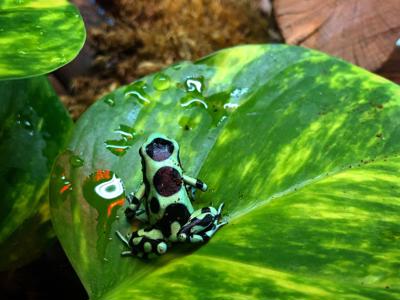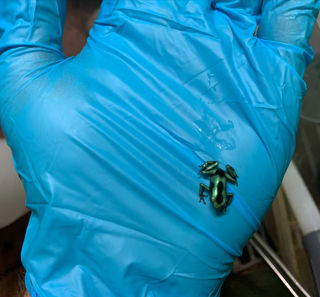
Green and Black Poison Dart Frog

General Information
The green-and-black poison dart frog is a brightly colored member of the order Anura native to Central America and northwestern parts of South America. This species has also been introduced to Hawaii where it is now an invasive species.
The green-and-black poison dart frog is found in the humid lowlands from southeastern Nicaragua on the Atlantic slope and southeastern Costa Rica on the Pacific coast through Panama to northwestern Colombia.
Whilst this species is not the most toxic poison dart frog, is still a highly toxic animal. The very small amount of poison the frog possesses is enough to make a human heart stop beating. However, like most poison dart frogs, the green-and-black poison dart frog only releases its poison if it feels threatened, and wild specimens can be handled provided the human holding it is calm and relaxed.

Latin name - Dendrobates auratus
Class - Amphibia
Family - Dendrobatidae
IUCN Status - Least Concern
Habitat - Tropical Forest Lowlands
Distribution - Central and South America
The green-and-black poison dart frog, as with all poison dart frogs, loses its toxicity in captivity due to a change in diet. This has led some scientists to believe that the green-and-black poison frog actually takes its poison from the mites and other insects on which it feeds.
They feed on a diet of insects, travelling up and down trees using their specially adapted suction-cup discs on the ends of their toes. Their adhesive feet make them agile climbers in the hunt for their prey.
Fun Fact
This species was released onto Hawaii in 1932 to aid in mosquito control. They are now well established on a couple of the Hawaiian islands as an invasive species.

Sign up to our newsletter
Join our mailing list in order to keep up to date with Zoo news and special offers.

